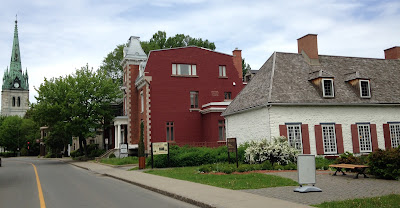 |
| The white building is a 1600's House Museum in 3R |
("3R" as the locals refer to it) is a good size city, you can see by the "Ma Bell" telephone booth in our campground that Canada is charmingly rural both in landscape and technology.
As in most cities, major fires in the 1700/1800's destroyed much, but many original buildings still remain. Numerous historical markers and tourist maps make it easy to navigate this small city on your own and it's so nice to hear church bells ringing on the hour. Surprisingly, a tour of the early 20th century Borealis Water Treatment Center for the Pulp and Paper Plant was quite interesting in understanding the role
lumber played in Canada's development. However, Debra found the vibes walking through the underground water cisterns (pictured above) to be really really creepy but way cool too.
Walking around downtown on Sunday morning, we come upon a large yoga/spiritual service beside the St. Lawrence River. I wish we had known about this as it would have been wonderful to participate. So great to see the flourishing of New Thought.

The purpose and highlight of this visit was the Centre d'archives de la Mauricie and Quebec. This FREE archive is one of nine in Quebec offering research on the history of families and regions. Our wonderful archivist spent three hours researching and printing off dozens of pages of John's genealogy based on this one piece of information about Johns great (to the 5th) grandfather - "James Richmond, born in England 1775, married Elisabeth Savard 9/26/1802 at Saint James Anglican Church, Trois-Rivieres". St. James Church is abandoned now but still standing as you can see in the picture with John.
 |
| St. James Church where the town surrendered to British rule |
He was able to trace this ancestor's wife back to one of the first Canadian settlers from France in the early 1600's!!! We then drove a half hour east to the hamlet of Baie-du-Febvre where James Richmond emigrated (via Boston Mass), and met a local girl named Elisabeth. Wonder why he went there in the first place?
Synchronicity #1: Although James and Elisabeth signed the church's marriage log with an "x"; one of the church employees who witnessed the signing was a George (our last name)! However, the (our last name)'s from Ireland, didn't get into this family tree until many generations later in Winona, Minnesota.
The Baie-du-Febvre cemetery has headstones dating back to the mid 1700's through today, with their ancestors names everywhere. We ran out of time or would have stopped at the town store to see if we could find some living relatives. Will need to brush up on our French before our next trip as few speak English here. We found a sign saying that this farming town of about 1,000 people, is a well known Spring and Fall snow geese migration site.
 |
| A main street in Baie-du-Febvre |
Synchronicity #2: Debra remembers her first visit to Three Rivers when she was 18 and on her honeymoon visiting first husband, Jim's relatives. Jim's mother was French Canadian and was born in 3R. How weird is it that both husband's families are from 3R???






















